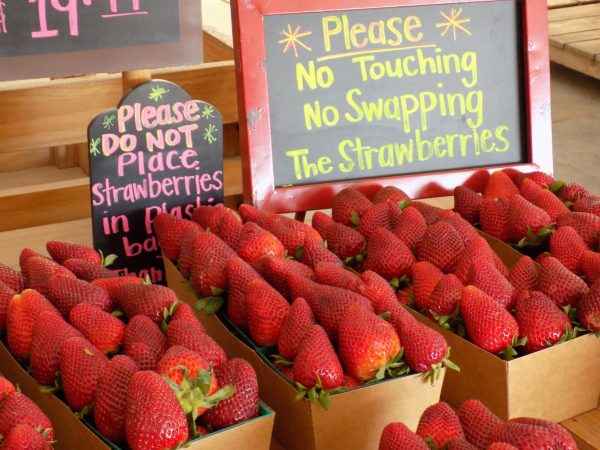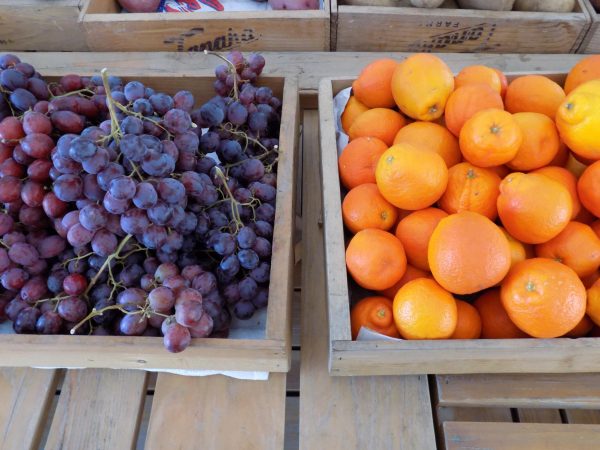Your usual grocery store offers you rows and rows of fruits and vegetables–- a rainbow of apples, corn, oranges, cauliflower, etc, but many of them are not ripe locally year-round. In fact, many are imported from the nutrient-rich soil of Mexico. So, how much of the fruits and vegetables in the grocery store actually come from Southern California?
California’s climate is mild and the sun shines for most of the year, making the state the perfect fertile environment for a variety of different produce like avocados, melons, strawberries, grapes, and citrus to be grown. An estimated one-third of the vegetables and three-quarters of the U.S.’s’ fruits and nuts are grown in the Golden State according to the California Department of Food and Agriculture (CDFA).
“We grow just about anything [in California],” said Glenn Tanaka, an owner and farmer of Tanaka Farms.
Although many fruits and vegetables become ripe across a few seasons, here is a guide to which produce is ready to be eaten seasonally based on which they are ripe in the longest.

(Shelby Young)
Spring
(March 19th – June 20th, 2024)
As the sun begins to shine more often and the weather warms, strawberries, artichokes, asparagus, avocados, broccoli, carrots, cauliflower, cherries, grapefruit, and potatoes become eagerly ripe.
Summer
(June 20th – September 22nd, 2024)
“In the summer time it is tomatoes, cucumbers, and corn [that are the ripest],” said Tanaka.
When people frolic in mass to the beaches of California’s coast, figs, grapes, green beans, watermelon, cantaloupe, honeydew, blackberries, blueberries, mulberries, peaches, passion fruit, nectarines, pears, plums, bananas and zucchini are ripe.
Autumn
(September 22nd – December 21st, 2024)
As the leaves change from green to a pallet of oranges, reds, and yellows and the weather steadily grows chillier, apples enter their golden era.
“It’s pretty hard to grow fruit trees year-round. We have to get our apples from up north a lot because they require a certain chill,” said Greg Goran, the Farm to Fork teacher at Huntington Beach High School.
Apple trees need a cooler climate than Southern California can provide – aside from the autumn and winter seasons – for the tree’s molecules to break down to form blossoms. It is then that apples begin growing, making their way into the rainbow assortment of the grocery store and into the hands of customers.
Along with apples, artichokes, beets, bell peppers, blood oranges, Brussel sprouts, cauliflower, fennel, kale, Mandarin and Navel oranges, mushrooms, pomegranates, and radishes are also waiting to be harvested in Southern California during this season.
Winter
(December 21st – March 19th, 2024)
“In the winter months here, it is items like cabbage, cauliflower, broccoli, and lettuce [that are the ripest],” said Tanaka.
While autumn’s swirl of colorful leaves fall from tree branches, ushering in winter, beets continue to be in season. Alongside them are broccoli, cauliflower, fennel, kale, Meyer lemons, radishes, and sweet potatoes.
Notably, since lettuce is the ripest in the colder months of Southern California’s climate, “[t]he average lettuce travels 150 miles,” said Goran.

(Shelby Young)
It’s normal for produce to travel as no single county or state can produce all the fruits and vegetables it needs independently. It’s not just the land that prevents this, but also the demand for these products which means Southern California must import its produce from other regions, nationally and internationally.
Despite California’s impressive contribution to food production in the U.S., there are still other components farmers must consider when deciding what to grow here, determining how much produce must be imported.
“It’s more than just the factor of whether or not [certain fruits and vegetables] can grow here, it’s a matter of: is the land cheap enough [and] is the labor available?” said Tanaka.
California’s lush benefications to the produce industry come from a collection of counties where the land is nutrient-rich and affordable and there are enough people to hire to run a farm and business.
In a census taken by the CDFA in 2022, the department found the top agricultural counties in California; of these, three are located in Southern California. Kern, is most notable for grapes and citrus, Imperial for its lettuce and carrots, and Santa Barbara for its strawberries and cauliflower. Together these countries make up 30% of the top agricultural producers in California.
Understandably, grocery stores don’t locally source all fruits and vegetables due to changes in seasons and the need to maintain its wide selection year round, but local farms like Tanaka offer produce stands and services that help locals buy fresh, seasonal produce and contribute to community businesses.








